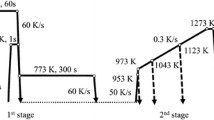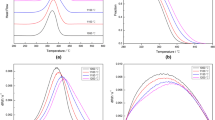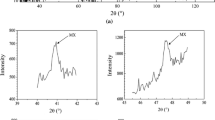Abstract
The effect of tempering on the decomposition of retained austenite in a powder metallurgy (PM) high-speed steel, GPM A30, has been monitored with a high-speed dilatometer. The corresponding microstructures of specimens with different tempering cycles have been investigated by a combination of scanning electron microscopy and analytical transformation electron microscopy. The as-quenched structure of the steel studied is composed of retained austenite, untempered martensite, and carbides. The results indicate that the complete transformation of retained austenite can be more nearly accomplished by double or triple tempering cycles than by a single long-time cycle. The possible transformation mechanism for the decomposition of retained austenite during multiple tempering cycles is attributed to the invariant-plane-strain of the prior martensitic transformation extending accommodation defects to the adjacent retained austenite, which favors further transformations in the subsequent tempering operations.









Similar content being viewed by others
Notes
GPM A30 is a powder metallurgy (PM) high-speed steel grade produced by Gloria Material Technology Corporation (GMTC)
References
F.B. Pickering, Materials Science and Technology: A Comprehensive Treatment, Vol 7, R.W. Cahn, P. Haasen, and E.J. Kramer, Ed., Wiley-VCH Publisher, New York, Dec., 1991, p 593-597
T. Mukherjee, Physical Metallurgy of High-Speed Steels, Proc. Conf. on Materials for Metal Cutting, Apr. 14–16, 1970, iron and steel inst.
Mohanty O.N. (1995) On the Stabilization of Retained Austenite: Mechanism and Kinetics. Mater. Sci. Eng. B: Solid State Adv. Technol B32(3):267-269
Cambronero L.E.G., Gordo E., Torralba J.M., Ruiz-Prieto J.M. (1996) Comparative Study of High Speed Steels Obtained Through Explosive Compaction and Hot Isostatic Pressing. Mater. Sci. Eng. A A207(1):36–45
kremnev L.S. (1991) Theory of Alloying of High Speed Steels. Met. Sci. Heat Treat 33(5–6):428-434
Wilson R. (1975) Metallurgy and Heat Treatment of Tool Steels, McGraw-Hill Book Co. Ltd, New York, pp 163–194
George A. Roberts and Robert A. Cary, High Speed Steels, Tool Steels, 4th ed., American Society for Metals, Inc., 1980, p 627–761
Hoyle G. (1988) High Speed Steels, 1 Butterworth Press, Boston
Honeycombe R.W.K., Bhadeshia H.K.D.H. (1995) Steels: Microstructure and Properties, 2 Edward Arnold, London, p 171
R. Wang, H.O. Andren, H. Wisell, and G.L. Dunlop, Role of Alloy Composition in the Precipitation Behavior of High Speed Steels, Acta Metall. Mater.,40(7), Jul., 1992, p 1727–1738
Author information
Authors and Affiliations
Corresponding author
Rights and permissions
About this article
Cite this article
Yu, T., Chen, C. & Yang, J. Decomposition of Retained Austenite in a High-Speed Steel GPM A30. J of Materi Eng and Perform 16, 102–108 (2007). https://doi.org/10.1007/s11665-006-9016-9
Published:
Issue Date:
DOI: https://doi.org/10.1007/s11665-006-9016-9




